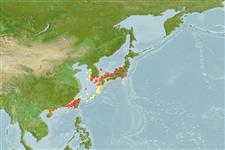Classification / Names
Common names from other countries
Main reference
Size / Weight / Age
Max length : 58.0 cm TL male/unsexed; (Ref. 89707); common length : 30.0 cm TL male/unsexed; (Ref. 2852); max. published weight: 2.5 kg (Ref. 40637)
Length at first maturity
Lm ?, range 23 - ? cm
Environment
Marine; reef-associated; depth range 1 - 55 m (Ref. 89707)
Climate / Range
Tropical, preferred ?; 39°N - 20°N, 109°E - 143°E (Ref. 5222)
Distribution
Northwest Pacific: southern China, Taiwan, East China Sea, Korea, and southern Japan (Kyushu to about 38°N on both coasts of Honshu). Reported specimen from Viet Nam may be Epinephelus fasciatomaculosus and records from the Philippines and India are unsubstantiated.
Countries | FAO areas | Ecosystems | Occurrences | Introductions
Short description
Dorsal
spines
(total): 11;
Dorsal
soft rays
(total): 15-17;
Anal
spines: 3;
Anal
soft rays: 8. Distinguished by the following characteristics: head and body pale brownish grey, covered with small red, orange or gold spots except on ventral side; 6 faint oblique dark bars on body; dark brown blotch on body at base of the 3 dorsal fin spines; dorsal fin margin yellow or orange; row of dusky yellow or orange spots along middle of the spinous dorsal fin and another row along the base of the fin; faint red or orange spots at caudal and anal fins; body depth less than head length, 2.7-3.2 times in SL; head length 2.3-2.6 times in SL; preopercle with enlarged serrae at angle; upper edge of operculum straight; subequal posterior and anterior nostril; maxilla reaching about to vertical at rear edge of eye; two rows of teeth at midside of lower jaw; pelvic fins not reaching anus; caudal fin rounded; lateral body scales ctenoid, with auxiliary in adults (Ref. 089707).
IUCN Red List Status (Ref. 115185)
Threat to humans
Harmless
Human uses
Fisheries: minor commercial; aquaculture: commercial
More information
ReferencesAquacultureAquaculture profileStrainsGeneticsAllele frequenciesHeritabilityDiseasesProcessingMass conversion
Tools
Special reports
Download XML
Internet sources
Estimates of some properties based on models
Phylogenetic diversity index
PD50 = 0.5000 many relatives (e.g. carps) 0.5 - 2.0 few relatives (e.g. lungfishes)
Trophic Level
4.0 ±0.65 se; Based on food items.
Resilience
Medium, minimum population doubling time 1.4 - 4.4 years (Assuming tm=2)
Vulnerability
Moderate to high vulnerability (46 of 100)
Price category
